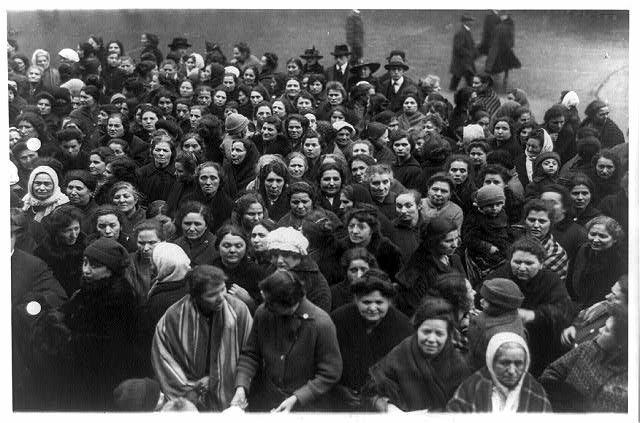In February of 1917, thousands of local women organized to combat sharply rising food prices. Spurred on by well-known anarchist and socialist leaders, many protesters turned violent and wreaked havoc on local businesses for several days.
It is hard for us to imagine not having a C-Town nearby or a 24-hour bodega on every corner to satisfy our cravings at a moment’s notice. In a world before supermarkets—let alone packaged foods, microwaves and refrigerators—families had to purchase fresh groceries on a near daily basis from separate vendors and regularly prepare meals from raw materials. This responsibility usually fell on the wives and mothers of the house, who spent much of their days planning and preparing family meals based on a nominal budget of a few cents.
According to one housewife’s account [1], the average cost of preparing dinner her medium sized family (for dinner alone) in 1916 was .76 cents per meal, or $22 a month, broken down as such:
2 pounds of onions = .06 cents
4lbs of potatoes = .08 cents
2.5lbs of meat = .40 cents
4lbs of bread = .12 cents
1/4lb of butter = .08 cents
1lb of cabbage = .02 cents
This might sound great to you and me, but the average full-time worker in 1916 was lucky to make $40 a month and pay upwards of $15 a month for rent. Also consider other household expenses such as heat, electric, clothing, health care and transportation. . Despite general misconceptions, living in the slums was not necessarily cheap.
By the beginning of 1917, with the United States only weeks away from entering World War I, grocery prices skyrocketed and the average cost of dinner exploded for that same housewife to $1.99 per meal—or $59 a month:
2 pounds of onions = .40 cents
4lbs of potatoes = .28 cents
2.5lbs of meat = .60 cents
4lbs of bread = .37 cents
1/4lb of butter = .14 cents
1lb of cabbage = .20 cents
To make a bad situation worse, customers at the time complained about getting much less for their money. To cut corners, for example, butchers who customarily trimmed away bone and excess fat before weighting meat abandoned the practice and began charging for these parts. Consumers also bemoaned a new trend; markets freezing vegetables in order to preserve them longer. The problem for shoppers was that water condensation on the vegetables made them heavier, driving the cost per-pound of many products even higher.
Many were forced to pawn family heirlooms, alter their dietary habits or cut back on meals altogether. Though the cost of living went up for everyone, it made dramatic differences in the lives of residents living in low-income districts like the Lower East Side.
“It used to cost 49 cents to provide breakfast for the four of us. Today the same breakfast would cost $1.02,” one resident told a New York Times reporter in February, 1917, adding, “We haven’t had an egg in months and potatoes are a luxury.”
In what may be chalked up to mass hysteria or misdirected anger, many consumers began to take their frustrations out on store owners and street vendors. And in an era in which almost everyone was a member of some sort of social, labor or political club, mobilizing large numbers of people was achieved rather easily. In this case, housewives from dozens of organizations joined forces to battle what many saw as price gouging on the part of retailers.

Leading the uprising was president of the socialist-based Mothers’ Vigilance Committee, Ida Harris, along with well known anarchist “Sweet Marie” Ganz. Both women were part of a newly-formed committee called the Mothers’ Anti-High Price League (also referred to as the Mothers’ Anti-High Cost League in some sources).
As rumors spread throughout New York City’s Jewish slums about retailers conspiring to drive up prices, a boycott on produce as well as a series of physical attacks and vandalism began on shops and street peddlers on February 19, 1917. Small organized mobs of women systematically targeted vendors over the next several days; hurling rocks, dousing merchandise with kerosene and assaulting customers who failed to oblige the imposed boycott.
On the morning of February 20, the Mothers’ Anti-High Price League gathered at the Forward Building’s auditorium, 176 East Broadway, for an advertised meeting, followed by outdoor speeches in nearby Rutgers Park. As the crowd grew into the hundreds and spilled onto East Broadway, Ida Harris and Marie Ganz led an impromptu march to City Hall.
An estimated one-thousand women converged on the gates of City Hall Park where a few unprepared police officers were overwhelmed. 300 to 400 marchers were able to break through and make it up the steps before iron gates were slammed shut at the door. The enraged women—many with infants in tow—began shouting in both English and Yiddish, “We want food for our children!”
The frenzy was nearly quelled when a mayor’s representative appeared from a window and promised to allow three representatives to meet with the mayor later that day if everyone went home quietly.
According to reports, women began leaving when a few agitators, including Marie Ganz, “harangued” what was left of the crowd “in bitter language,” inciting a small riot. In the end, Ganz was the only person arrested for failing to comply with orders to stop stirring up the crowd.
“Sweet Marie,” who earned her nickname because she had “the vocabulary of a deckhand on a Mississippi River steamboat,” was arraigned later that day at the Tombs and released with a suspended sentence. However this was not the instigating activist’s first run-in with the law; Ganz, who lived in a two room apartment with her mother and two brothers at 220 Delancey Street, was by that time well known to police, media and the public. She was a highly visible, outspoken leader of the early century anarchist movement, most famously making headlines in 1914 for publicly threatening to “shoot down” John D. Rockefeller, Jr. “like a dog.” For that threat, she received 60-days in a Blackwell’s Island workhouse. At Ganz’s sentencing for the threat, she laughed and said, “I would much rather be what I am and be going where I’m going, than be John D. Rockefeller, Jr. and bound where he is going.”
At the advice of Jewish Daily Forward editor Abraham Cahan, Ida Harris and the Mothers’ Anti-High Price League outlined a list of demands, which included an immediate request to the “city, state and national governments” for $1,000,000 to establish and stock “municipal stores” and another $1,000,000 for a public school lunch program.
As the League lobbied the government, violence escalated in Jewish immigrant neighborhoods across the city. On February 22, protestors turned their attention from produce retailers to poultry markets, attacking customers and destroying chickens on site.
“Through Pitt, Ludlow, Rivington, Essex, Suffolk and all of the east side streets the crowd surged, passing from one shop to another… waving the heads and wings and mutilated bodies of chickens” reports the New York Times.”
Complicating matters, word spread quickly that the whole rebellion was a manufactured German plot and agitators were paid to incite residents to riot. This rumor of unknown origins implied that there was not a real need for assistance.
On Saturday, February 24, thousands of consumers from the Five Boroughs marched on Madison Square, where several high-profile speakers addressed the crowd. At the head of the procession was a white flag which read, “Starvation.”
By the beginning of March, the city responded to the crisis by securing thousands of pounds of low-cost produce and wholesalers lowered prices. Though violence waned for the most part, this was only a temporary fix as prices fluctuated sharply throughout the war.
(Feature image: Protesters at the steps of City Hall in February, 1917. Source: International Socialist Review, April 1917/Library of Congress.)
Article originally written for The Lo-Down:
http://www.thelodownny.com/leslog/2013/02/les-history-the-food-riots-of-1917.html

Eric is a 4th generation Lower East Sider, professional NYC history author, movie & TV consultant, and founder of Lower East Side History Project.
